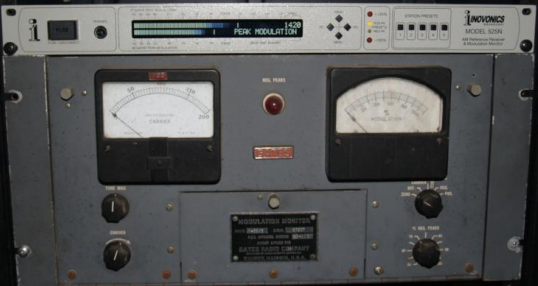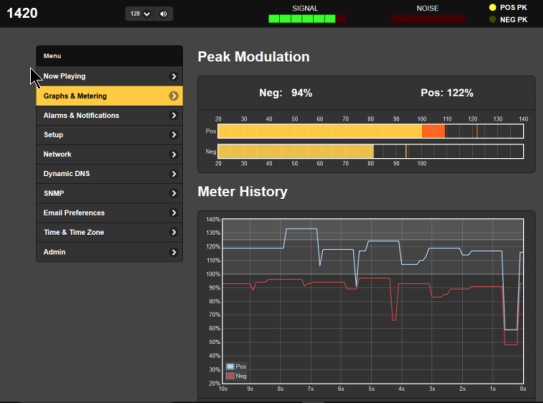Inovonics 525N AM Modulation Monitor

[November 2016] The most basic, simple to use diagnostic tool for AM stations is the Modulation Monitor. Inovonics Model 525N displays the most important parameters clearly – and then gives you a lot more. Alan Alsobrook takes a look at the 525N.
Following the FCC’s efforts at deregulation, many AM stations have long since allowed their old AM Modulation monitor to fade into poor condition and have not refurbished nor replaced this needed device.
In case you are wondering, you do still need to make sure your AM station is in compliance with all FCC Rules, including those regarding modulation.
After seeing the new Inovonics 525N AM Modulation Monitor at the Spring NAB Show in Las Vegas, I thought it was a good time to take a close look at it.
I wanted to see how good the Model 525N it is in giving the engineer what he needs to know about the signal.
A Quick Setup
From my first look when I pulled the Inovonics 525N AM Mod Monitor out of the box, I was impressed. The 1-rack-unit model is a good addition to Inovonic’s series of intelligent products.

An Inovonics 525N sitting on an old Gates Mod Monitor. Despite being much smaller, the tech built in provides much more information.
The 525N is very intuitive and easy to set up for operation. Once plugged in and turned on it took only 5 minutes or so to get it set up on the network, I found the setup procedures simple and done easily without looking at the instructions – not that any of us would ever set up new equipment without looking at the book.
It took a bit longer to run some RG-6 outside and hook up the antenna. (The 525N comes packed with an unshielded loop antenna for picking up off-air signals.)
Looking at the rear connections you have an F connector for the antenna, as well as a BNC for your high level input. The audio output is a balanced XLR connection.

The back side of the 525N
Then there is a plug in compression connector for alarms (over-modulation, carrier loss, and Audio loss). Finally you see the Ethernet connection for networking the device.
Rolling Through the Display
On the front panel of the 525N you have a monochrome display that includes the most important information: modulation, frequency, and any alarms.

The front panel also includes a four-button control pad, five preset frequency buttons, the headphone jack and, of course, the peak flashers for +125, -100, and the user-defined positive and negative flashers.

The five station selection buttons allow instant access to each of the pre-programmed stations.
Alternatively, it can, of course, be left on the user station’s frequency and be used as a reference receiver for critical listening of the station’s signal.
Exploring the Feature Set
All my tests of the usual modulation monitor functions checked out as very accurate, so let us move on to the various useful programmable options I found.
Among them were the rear alarm connections which are programmable to either open or closed to ground on an alarm condition. The audio output has several options as well: you can select NRSC emphasis as well as set the pass bandwidth in 1 kHz increments from 2 kHz to 10 kHz (or flat).
What I find especially exciting about this monitor are the networking features along with the web-based GUI that makes programming it a breeze, so I will delve into those features.
GUI
The first thing about networking is, of course, setting up the network connection. This was easy – I just let DHCP do its thing – but you do have a front panel capability to set up a manual connection if needed or desired. Once connected to the network, the box can use an NTP server to keep its time updated; this is nice for the alarm logs.
The web page GUI is basic, easy to navigate, and very functional, whether you are on-site, or half a continent away.

As part of the clear and comprehensive series of menu options, the unit has an easy to use email area for up to 10 different addresses and each address can be programmed individually as to what notifications each one should receive. As SNMP is becoming more popular for facility monitoring, a configurable interface is also included for stations that want to use it.
This is an analog only monitor, no CQUAM, or HD, but the factory assured me it is able to properly demodulate and measure the analog carrier even on an HD station. I do not have any HD AM’s in my area so I could not verify that, but I suspect it is true.
According to Inovonics this unit uses a proprietary synchronous detector that has a high rejection of anything that is not phase-locked to the AM carrier. This allows it to basically ignore the HD carriers and read the analog modulation without influence from the HD signal.
Also of concern is how the new modulation dependent carrier level (MDCL) will affect the metering. Inovonics reported that thus far in their testing, the unit responded accurately to MDCL signals. Currently MDCL stations are very few so testing has not been extensive and will continue.
Even More Signal Monitoring
Another nice, and unexpected, feature is the unit has audio streaming capability.
You can select from 32, 64, or 128 kBps stream. I did note that the stream start button would not start for me on FireFox, yet it worked just fine on Windows edge.
Even stranger, once I started it on Edge, it would sometimes work on FireFox. That one I cannot even start to explain but after checking with Inovonics, they said the stream feature was tested with all popular browsers, so perhaps it is just an oddity on my network.
Also I noted that the stream is a few seconds delayed from the meters which is to be expected due to stream buffering..
The 525N did not seem to have any problem serving pages to three users simultaneously. I did not test past that point, I was running out of computers with which to test.
Minor Quibbles
There were a couple of items I thought might be improved, possibly via a firmware update.
The first was with all these nice fancy email alarms. It would be very nice if they had a timer-based function so you would not get alarms every day at sundown at a daytimer that has to shut down, or at a station that changes patterns where the signal strength varies widely.
The folks at Inovonics are considering this, as indeed they do for any and all suggestions from the field, which they listen to and attempt to satisfy customers.
I also noticed the unit did tend to lose its memory after a several-hour power outage. I suspect it is using a large capacitor for memory retention. I am not sure at what point this happens as it takes a few hours of power loss before the memory failure occurs.
All in all, this one is definitely an affordable and much needed update for many stations.
– – –
[Editor’s Note: After this article was posted, Inovonics’ Senior Development Engineer Josh McAtee at told us, “There was a bug involving the unit “factory defaulting” on power-up under specific conditions (large alarm log), but that issue has been fixed.”]
– – –
More information about the Inovonics Model 525N Modulation Monitor is located here.
– – –
Alan Alsobrook is a regular contributor to The BDR. He is contract engineer based in St. Augustine, FL. Contact him at: aalso@bellsouth.net
